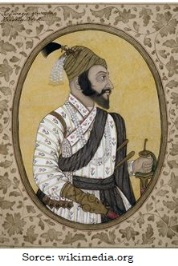Shivaji Maharaj
• Shivaji was born on 19th February, 1630 in the Shivneri fort, near the city of Junnar in modern day Pune district.
• Shivaji's father Shahaji Bhonsle was a Maratha general who served the Deccan Sultanates. His paternal grandfather Maloji was also a general of Ahmadnagar Sultanate. He was awarded the epithet of "Raja". He was also given fort Shivneri for his family's residence.
• Shivaji’s mother’s name was Jijabai. She had a great role in making Shivaji a warrior. He studies of the Hindu epics like Ramayana and the Mahabharata which make life long influence on him.
• Shivaji was the second son of Shahaji. Shivaji’s elder brother was Sambhaji Bhosale.
• When his father Shahaji had married Tuka Bai (second wife), both Shivaji and Jijabai moved from Shivneri to Pune. Here his care taker was Dadoji Kondadeo who had make significant influence on the personality development of the young Shivaji.
• Shivaji married Saibai in the year 1640. Shivaji had total of eight wives.

• In 1645, Shivaji capture Torna Fort, Chakan fort and the fort of Kondana of Bijapur Sultan.
• In 1648, in a bid to contain Shivaji, the Bijapuri ruler Mohammed Adilshah ordered the imprisonment of Shivaji’s father Shahaji. Later, Shahaji was released in 1649.
• From 1649 to 1655 Shivaji paused in his conquests and quietly consolidated his gains.
• Following his father's release, Shivaji seized the valley of Javali, near present-day Mahabaleshwar in 1656.
• In 1657 Adilshah of Bijapur sent Afzal Khan to arrest Shivaji. But Afzal Khan was not able to capture the fort. So after two months of siege, Afzal Khan sent an envoy to Shivaji suggesting the two leaders meet in private outside the fort. During the meeting, when Afzal Khan attacked Shivaji, Shivaji's “bagh nakh ” (tiger claws) inflicted mortal wounds on the general. Afzal Khan died in the battle and his army defeated at the Battle of Pratapgad.
• Shivaji's confrontations with the Mughals began in March 1657, when Shivaji’s army raided the Mughal territory near Ahmednagar. Mughal emperor Aurangzeb sent his maternal uncle Shaista Khan, with an army numbering over 150,000 in January 1660 to attack Shivaji.
• Shaista Khan after seizing the city of Pune, he resides at Shivaji's palace of Lal Mahal. In April 1663, Shivaji launched a surprise attack on Shaista Khan in Pune. Shaista Khan escaped, but he lost a finger in the fight.
• Aurangzeb now sent Rajput Mirza Raja Jai Singh I. He successfully besieging the fort of Purandar, and managed to force Shivaji to sign the Treaty of Purandar. The treaty was signed on 11 June 1665 which is known as the Treaty of Purandar. As per treaty, Shivaji agreed to give up 23 of his forts, keeping 12 for himself. Shivaji agreed to become a vassal of the Mughal Empire, and also agree to send his son Sambhaji, along with 5,000 horsemen, to fight for the Mughals in the Deccan as a mansabdar.
• In 1666, Aurangzeb summoned Shivaji to Agra along with his nine-year-old son Sambhaji. In the court, on 12 May 1666, Aurangzeb made Shivaji stand behind mansabdars of his court. Shivaji took offence and stormed out of court. He was placed under house arrest under the watch of Kotwal of Agra. But Shivaji was managed to escape from Agra by smuggled himself and his son out of the house in large baskets, claimed to be sweets to be gifted to religious figures in the city.
• During the period between 1666 and 1668, Aurangzeb conferred the title of raja on Shivaji. Sambhaji was also restored as a Mughal mansabdar. Aurangzeb also permitted Shivaji to attack the decaying Adil Shahi. The peace between Shivaji and the Mughals lasted until 1670.
• On 6th June 1674, Shivaji was crowned as king of Maratha Empire at Raigad fort. Shivaji had also titled Shakakarta and Chhatrapati conferred upon him. He also took the title of Haindava Dharmodhhaarak (protector of the Hindu faith). This second coronation took place on 24th September 1674. With the coronation, Shivaji became an independent ruler. Shivaji made Raigarh as his capital.
• He appointed eight ministers who were called ‘Astapradhan’ who assists him in the administrative helm of affairs. He is also known as the father of Indian navy. He was also the pioneer of guerrilla warfare in India.
• After the coronation, Shivaji took an aggressive campaign and extended his empire. During his reign, Shivaji had the possession of around 370 forts. The whole Konkan coast was under him.
• Shivaji died on 3rd April 1680 at the age of 52 at Raigad Fort, Pune.

Practice Test Exam